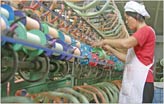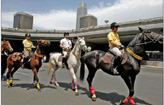Business
Subway dishes up a Chinese growth
Updated: 2011-06-14 13:52
By Hu Haiyan (China Daily)
BEIJING - To attract a wider audience in China, many Western fast-food chains have altered their menus to the Chinese palate: McDonald’s created a spicy chicken burger, KFC trashed its coleslaw in favor of bamboo shoots and fungus and Starbucks launched its green tea cream cappuccino.
Now it’s Subway’s turn. The sandwich restaurant chain is experimenting with Beijing roast duck sandwiches and sauces like a hot and spicy Sichuan sauce, part of its major campaign to capture a larger share of the fast-food market in China.
“In the medium to long term, it is absolutely part of our future to reach out and blend in with the local market,” said David Keir, Subway’s development agent in Shanghai.
But for the sandwich restaurant chain, which currently has about 200 outlets in China, the menu experimentation is just one of several measures Subway is working on to duplicate its success in the United States. It’s also considering slashing prices for its sandwiches and pushing forward on the franchise business model, which emphasizes small, low-cost outlets.
Fred Deluca, Subway president and founder, said he plans to have 500 stores in China in five years and will start by adding 35 to 50 stores this year. By comparison, McDonald’s has more than 2,000 stores, while KFC has more than 2,800.
Subway, which entered China in 1995, is specifically looking at second-tier Chinese cities because it has built a foundation in major cities such as Beijing and Shanghai.
But there might be a bigger target for this revamping: Catching up to McDonald’s presence in China in 10 years, something Deluca said will only happen if Subway accomplishes its 500- store goal.
“Since Subway is a privately owned company, we have more freedom and flexibility in adjusting our strategies, which is another advantage for our successful expansion,” Deluca said.
Subway’s reasons for success in China are numerous.In recent years, Subway has made a major push into international markets with its franchise business model.
“Subway is entirely franchiseeowned. at has been part of its success,” said Tony Pace, chief marketing officer of Subway’s Franchisee Advertising Fund Trust.
He said “the smaller-format stores cost less to open and operate than other chain restaurants”.
In 1999, Subway established measures to ensure its success in franchising. It set up a consulting group in 1999 made up of an advertising committee, franchisees association, purchasing departments, development agents and company delegates. Every four months, this consulting group regularly holds meetings to discuss the company’s development strategy. It plays a very important role in coordinating the roles of the franchisees and the Subway parent company.
Subway also provides training programs to the franchisees yearly. Biannually, the company will test the employees’ techniques in making sandwiches.
It has also achieved its rapid growth, in part, by opening outlets in nontraditional locations such as an automobile showroom in California, an appliance store in Brazil, a ferry terminal in Seattle, a riverboat in Germany, a zoo in Taiwan, a goodwill store in South Carolina, a high school in Detroit and a church in Buffalo, New York.
“We’re continually looking at just about any opportunity for someone to buy a sandwich, wherever that might be. The closer we can get to the customer, the better,” said Don Fertman, Subway’s chief development officer who said Subway now has almost 8,000 franchises in unusual locations. “e non-traditional is becoming traditional.”
What’s more, Subway’s emphasis on fresh eating and lots of vegetables will help the franchise chain grow as Chinese consumers become more aware of healthier eating, Deluca said. He added that China is starting to take note of rising obesity in the nation.
But now, as Subway expands into different provinces of China, it plans to change things up a bit, starting with localizing the menu, something it hasn’t done since entering the mainland. at lack of change has irked some Chinese-owned franchisees.
“Subway should have at least one item tailored to Chinese tastes to show that they are respecting the local culture,” said Luo Bingling, who operated a Subway in Beijing’s Haidian district.
Keir said Subway is doing trial research on new sandwiches, which may include Beijing’s ubiquitous roast duck.
“Chinese franchisees are very diligent, yet the lack of innovation is kind of common problem for this group. In this large market, innovation is very essential for franchising to succeed,” Deluca said.
He said the sandwich maker is considering lowering prices to attract more customers. A standard subway sandwich costs around 20 yuan ($3.08) compared with 6 yuan for a cheeseburger at McDonald’s.
“We have a very different business model to McDonald’s. We make smaller stores and tend to put a lot more of them around,” Deluca said.
The race for global dominance is an important one for the US fast-food industry, which has experienced high unemployment and economic uncertainty in the US. US fast-food chains are increasingly looking overseas for growth, particularly in Asia, said Huang Guoan, research manager of Beijing-based Sinotrust International Information & Consulting Co Ltd.
Subway, which opened its first international restaurant in 1984, in Bahrain, expects its number of international restaurants to exceed domestic ones by 2020, Fertman said. e chain currently has more than 24,000 restaurants in the US, where it generated $10.5 billion of its $15.2 billion in global revenue last year.
Subway’s China stores account for 0.6 percent of Subway’s global network of 33,749 stores with markets such as the US, Canada, Australia and the United Kingdom making up the bulk of revenue. In 2009, worldwide sales were $13.8 billion, of which China contributed only a “tiny” amount, Deluca said.
Last year, Subway surpassed McDonald’s as the world’s largest restaurant chain in total number of restaurants globally. It surpassed McDonald’s in the US about nine years ago.
At the end of last year, Subway had 33,749 restaurants in 95 countries and regions, compared to McDonald’s 32,737 in 117 nations and regions.
McDonald’s is still the leader when it comes to sales. The burger chain reported $24 billion in revenue last year. But Subway, if Deluca can help it, is fast making inroads into McDonald’s dominance.
Specials

Wealth of difference
Rich coastal areas offer contrasting ways of dealing with country's development

Seal of approval
The dying tradition of seal engraving has now become a UNIVERSITY major

Making perfect horse sense
Riding horses to work may be the clean, green answer to frustrated car owners in traffic-trapped cities